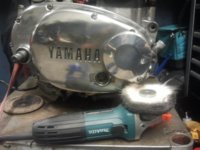desmodromic
XS650 Addict
does anyone have any suggestions about a specific grinder or buffer? The link at xs650choppers takes you to a video where the guy talks about using an angle grinder with a buffing wheel, but I don't see where they make specific angle grinder buffing wheels. I'd like to get a buffer, but they're so expensive, and the grinders really limit you in terms of how close you can get the bigger pieces on the wheel. I live near a Sears, HD and HF isn't that far.
Makita grinder with a Ryobi (home depot) polish kit for a drill.




